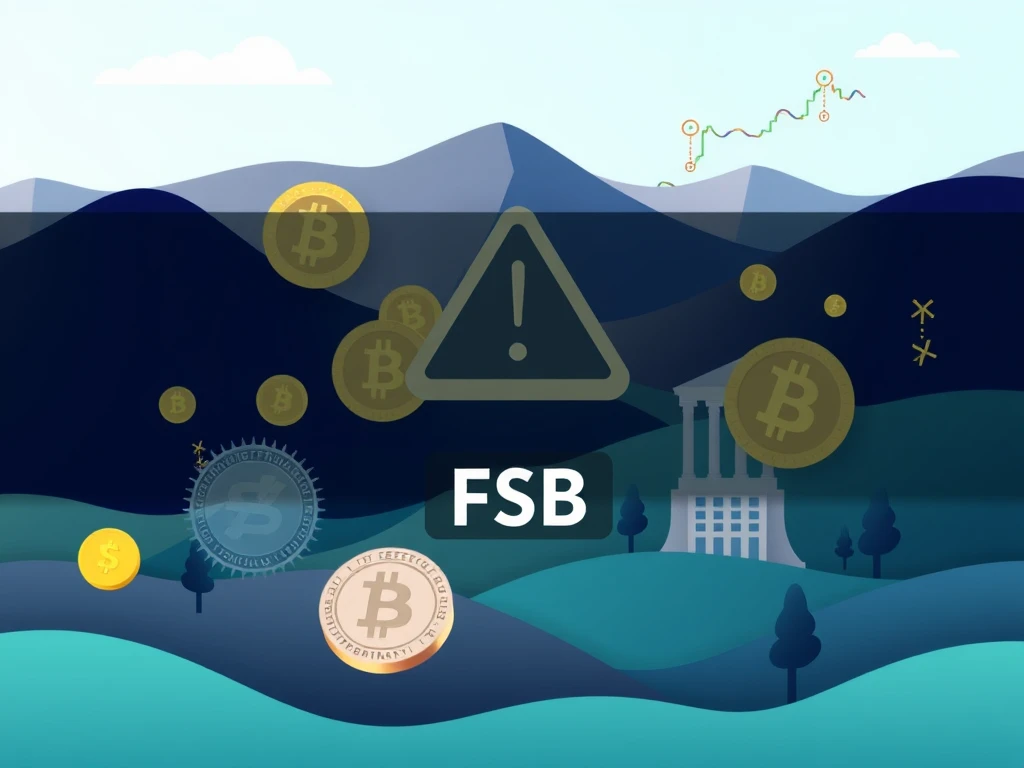Urgent FSB Crypto Warning: Systemic Risk Nears Tipping Point as TradFi Ties Deepen

The Financial Stability Board (FSB) has issued an important **FSB crypto warning**, indicating that the cryptocurrency sector’s growing connections with traditional finance (TradFi) are reaching a critical level. This development suggests that while crypto may not currently pose a major threat to global financial stability, that situation could soon change. It’s a topic of significant interest for anyone involved in digital assets, as regulatory perspectives directly impact the market.
Understanding the **Crypto Systemic Risk** Concern
Outgoing FSB Chair Klaas Knot recently highlighted that we might be approaching a ‘tipping point’ regarding **crypto systemic risk**. This means the interdependencies between the crypto market and the broader financial system are increasing to a degree where issues in one could significantly impact the other. Previously, the crypto market was largely seen as separate, but this view is evolving rapidly.
Several factors contribute to this increasing concern:
- Lower barriers to entry for retail investors.
- The proliferation of new investment products.
- The growing size and complexity of certain crypto segments, particularly stablecoins.
How **Crypto ETFs** and Stablecoins Fuel Integration
Klaas Knot specifically pointed to two key drivers accelerating crypto’s integration into traditional finance: crypto exchange-traded funds (ETFs) and stablecoins.
Crypto ETFs simplify access for retail investors. They allow people to invest in digital assets through familiar brokerage accounts without dealing with private keys, wallets, or complex exchanges. While beneficial for adoption, this also links traditional investment flows more directly to crypto market movements. The potential for **crypto ETF risk** emerges if sudden large flows or market volatility in crypto trigger reactions in traditional investment products.
Stablecoins, pegged to fiat currencies like the US dollar, are another major factor. Their market cap is substantial, exceeding $251 billion. Stablecoin issuers often hold significant reserves in traditional assets, including short-term US Treasurys. This creates a direct link, as large stablecoin market movements can influence demand and yields in these traditional markets.
The Impact of Stablecoins on Traditional Markets
Recent research from the Bank for International Settlements (BIS) provides concrete evidence of stablecoins’ influence. The study analyzed the impact of stablecoin flows on short-term US Treasury yields.
Key findings from the BIS paper include:
- Stablecoin inflows can lower three-month Treasury yields by 2–2.5 basis points within 10 days.
- Stablecoin outflows can raise yields by 6–8 basis points over the same period.
- These effects are most pronounced in short-term Treasury maturities.
- USDt (USDT) and Circle’s USDC (USDC) were identified as having the largest impact among stablecoins.
This demonstrates that stablecoins are not just internal crypto instruments but are becoming embedded in and influencing traditional financial plumbing, underscoring the need for careful monitoring and potential **stablecoin regulation**.
Navigating the Future of **Crypto Traditional Finance** Integration
The increasing ties between crypto and traditional finance necessitate clear regulatory frameworks. In the United States, the recent advancement of the GENIUS Act in the Senate signals progress toward establishing national guidelines for dollar-backed stablecoins. If passed, such legislation aims to provide regulatory clarity and potentially boost the US digital asset industry’s global standing.
As FSB Chair Klaas Knot prepares to step down, the focus on monitoring and potentially regulating the crypto sector will continue under new leadership, including Bank of England Governor Andrew Bailey at the FSB. The goal is to manage the evolving risks without stifling innovation.
Conclusion: Staying Ahead of the Curve
The FSB’s **FSB crypto warning** serves as a reminder that the crypto market’s growth is bringing it closer to the traditional financial system, increasing the potential for **crypto systemic risk**. Developments like **crypto ETFs** and the expanding role of stablecoins highlight the deepening connections. As **stablecoin regulation** and broader frameworks are discussed and implemented, the landscape for **crypto traditional finance** integration will continue to evolve. Staying informed about these regulatory discussions and market dynamics is essential for navigating the future of digital assets.








